Yangyang in Gangwon Province has a bit of everything. There are hills with beautiful scenery; hiking trails where you can stop and dabble your feet in clear streams; Naksan Temple, which has survived through a tumultuous history; and one of the best surfing beaches in Korea.
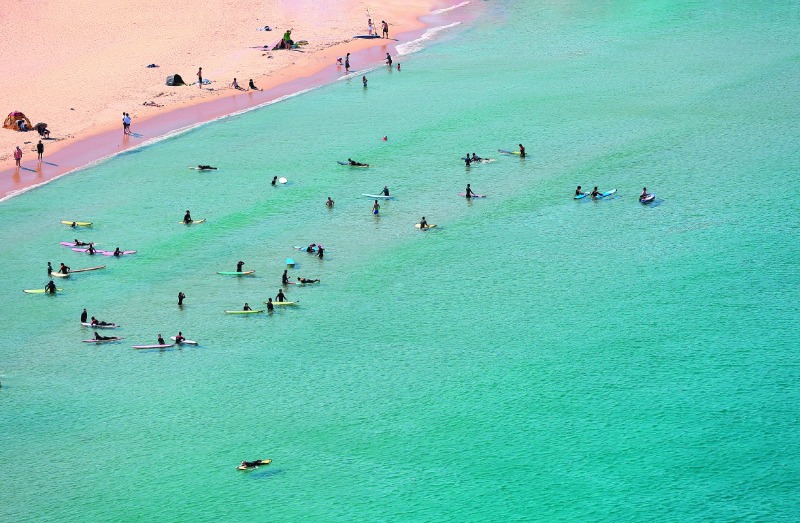
ⓒ gettyimagesKOREA
The slower you hike the mountain pass Hangyeryeong, the better, travelers say. That way you can soak in the spectacular scenery with every measured step. As you make your way up the winding road, it feels as if you are connecting with another world. For motorists, this route is one of the best drives in Gangwon Province and should not be missed, even if it means taking a bit of a detour.
This mountain pass is also known as Osaengnyeong, which means “a mountain range embracing a bitterly cold valley.” With an altitude of over 1,000 meters, it is the highest pass in the area. Yi Jung-hwan, a scholar of the late Joseon Dynasty, called it one of the six famous mountain passes of Gangwon Province in Ecological Guide to Korea (Taengniji) written in 1751.
HILLS AND ARCHITECTURE
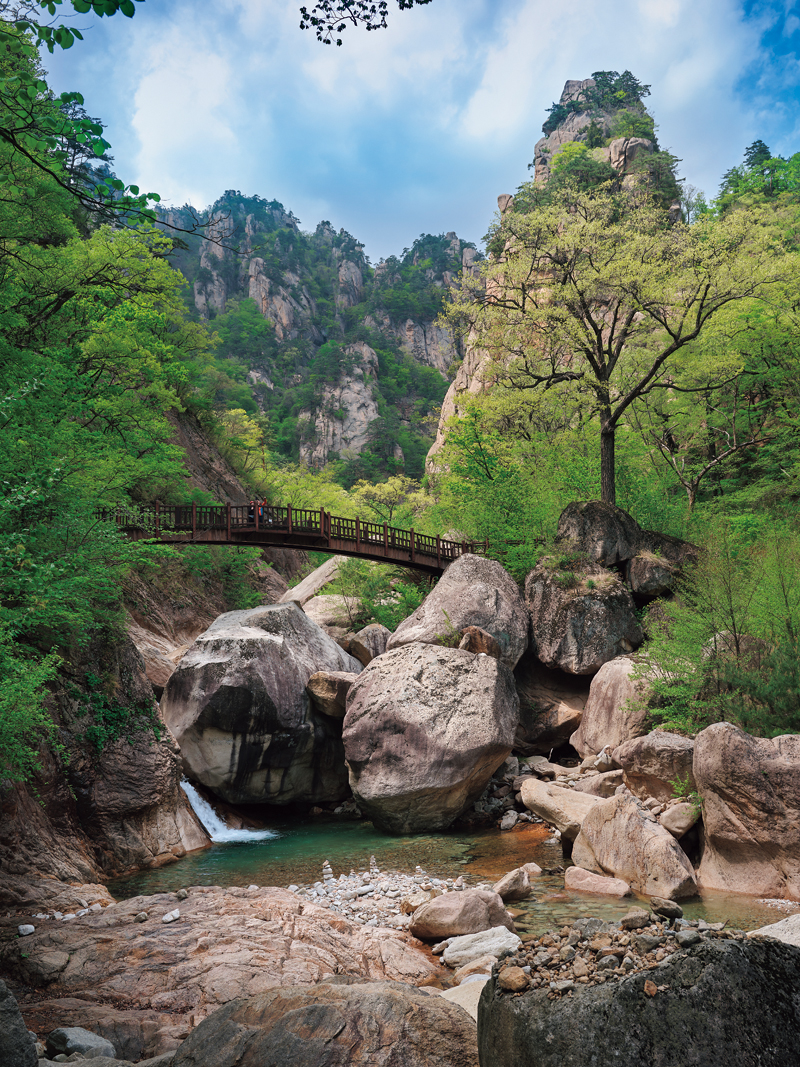
Mt. Seorak is one of the country’s most beloved mountains. The beautiful Jujeon Valley situated in Namseorak, or Osaek District, to the south of Hangyeryeong, is a popular destination among hikers. The deep valley is cool even in midsummer, and the oddly shaped rocks create a spell-binding landscape.
At the top is the Hangyeryeong Service Area, a remarkable building erected in the early 1980s. Its roof is low so that it blends in with its natural setting without disturbing the atmosphere of Hangyeryeong, and the heights of different parts of the building are adjusted to create visual harmony with the surrounding mountains.
Designed by architects Kim Swoo-geun (1931–1986) and Ryu Choon-soo, the building takes the surroundings into careful consideration. Kim’s approach is renowned for its outstanding aesthetics of mindfulness. Unusually low-hanging eaves afford a clear view of Mt. Seorak and its green landscape in the background, and the terrace has a long reach. The open interior also allows uncluttered views of the East Sea beyond fantastic rock formations.
The first floor is designed to be as open as possible, so that passersby can stand under the eaves or come inside to escape rain and strong winds. It was constructed to recall an alleyway that invites an aimless, leisurely stroll. On an inside column, peer recognition is found on a metal plaque stating that the building won the 1983 Korean Institute of Architects Award. This is a tribute to its attentive design, which provokes thoughts about how humankind treats nature.
HOT SPRING AND HIKING
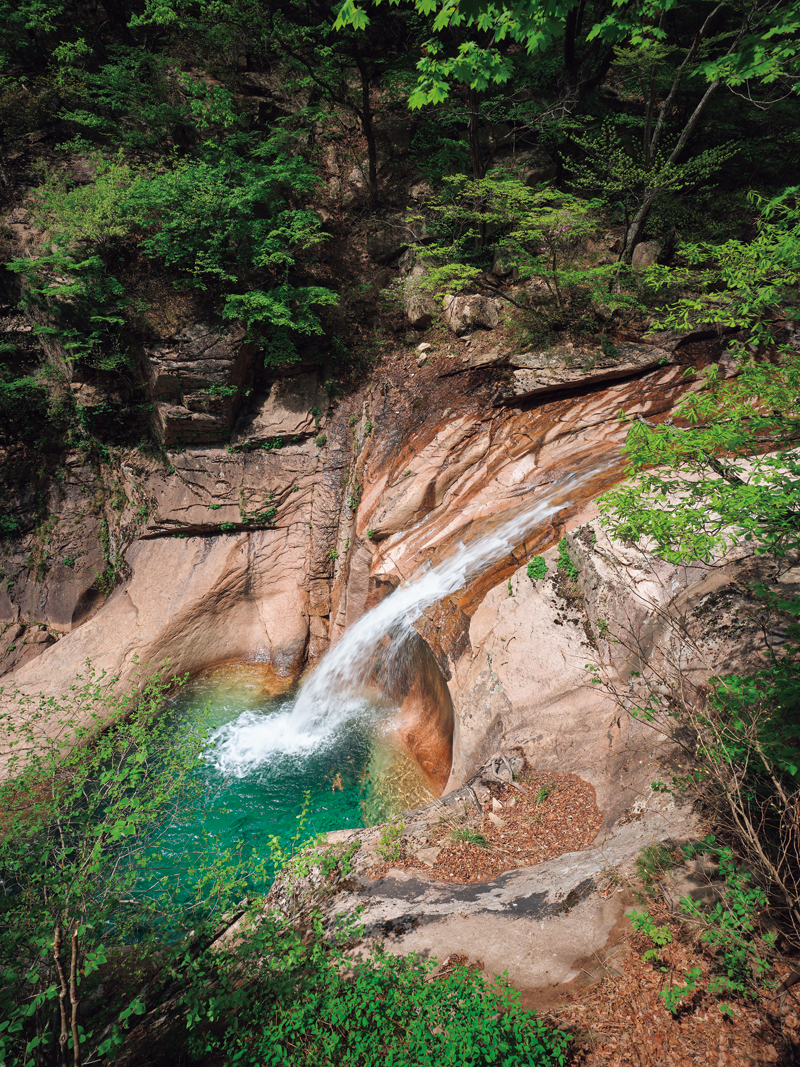
Yongso Falls at the entrance of Jujeon Valley is only ten meters high, and the water of the pond underneath just seven meters deep. Legend has it that two 1,000-year-old mythical creatures, one female and one male, became dragons and tried to ascend to heaven. But while the male succeeded, the female failed and turned into a rock and waterfall.
The winding road from the Hangyeryeong Service Area down to the east leads to the Yaksuteo Hiking Support Center at the entrance of Osaek Mineral Spring. Discovered by a monk in around 1500, it produces 1,500 liters of water per day. In recognition of its historicity and uniqueness, it was designated as a Natural Monument in 2001.
There is a theory that the Korean name of the spring, Osaek Yaksu, which means “mineral water of five colors,” originated from Osaekseok Temple, situated at the top of Jujeon Valley. It is said that trees with flowers of five colors grew around the temple. Therefore, the spring was named Osaek Mineral Spring, the village Osaek-ri, and the pass Osaengnyeong. Of course, all of this is just legend.
At first, the mineral water looks transparent, but it tastes metallic due to its high iron content. If left to sit for a long time, the water oxidizes and changes color from transparent to gray, then dark brown, ocher, and finally red. Hence the name “five-color mineral spring.”
Osaek Mineral Spring is the perfect starting point for hiking Jujeon Valley. For a one-day hike, there is a 3.5-km trail that continues to Seongguk Temple, newly built on the site of Osaekseok Temple, past Seonnyeotang, or the “fairy lake,” and up to Yongso Falls. It takes about two to three hours to get there and back.
Flagging hikers can recharge by soaking their feet in the cold water of a stream that noisily flows through the lush valley. The 700-meter section between Osaek Mineral Spring and Seongguk Temple is barrier-free, enabling elderly people and others who may have trouble moving to easily enjoy the magnificent scenery of Jugol Valley and even Mt. Seorak National Park.
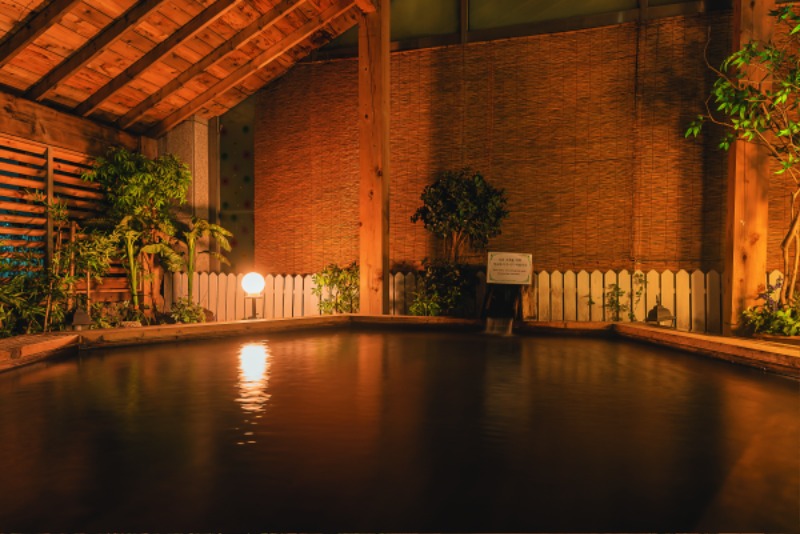
The Osaek Greenyard Hotel near Jujeon Valley has hot spring baths filled with Osaek mineral water. The carbonated hot spring offers carbonic acid, calcium, and iron to help relieve pain, fatigue, and gastrointestinal symptoms.
ⓒ Osaek Greenyard Hotel
After returning to Osaek Mineral Spring, a soak in the hot spring water soothes away weariness. The Osaek Greenyard Hotel, which has recently been remodeled, has hot spring baths filled with Osaek mineral water as well as a
jjimjilbang, a Korean-style dry sauna. For those feeling hungry after a bath in the hot springs, there are some 20 restaurants between the hotel and Osaek Mineral Spring. They offer a wide variety of dishes made with wild greens that cannot be found in city restaurants as well as dishes featuring dried pollack, which has been dried through repeated freezing and thawing. The whole meal tastes better when accompanied by some Gangwon Province
makgeolli (cloudy rice wine) made with corn kernels or
deodeok (bellflower) roots.
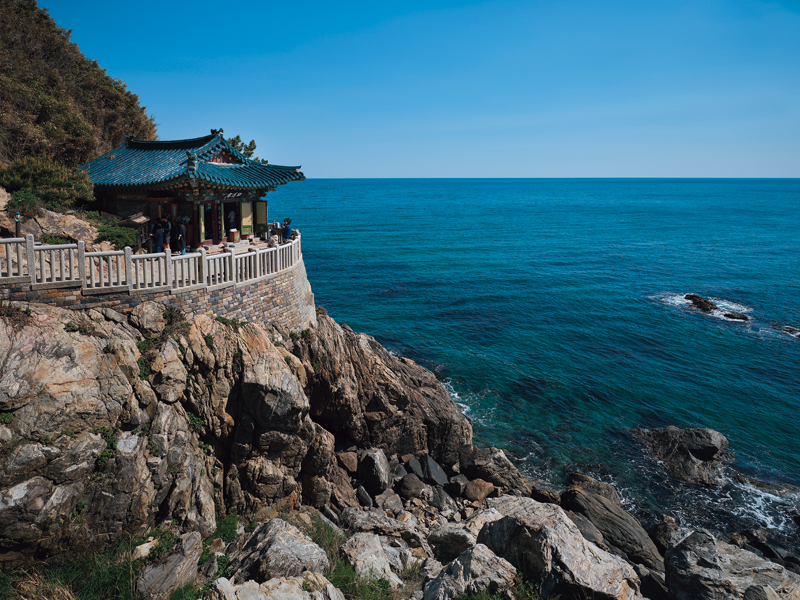
Hongnyeon Hermitage of Naksan Temple is a favorite place to watch the sunrise on the east coast. Perched on top of a sea cave, the seawater flows in and out right underneath.
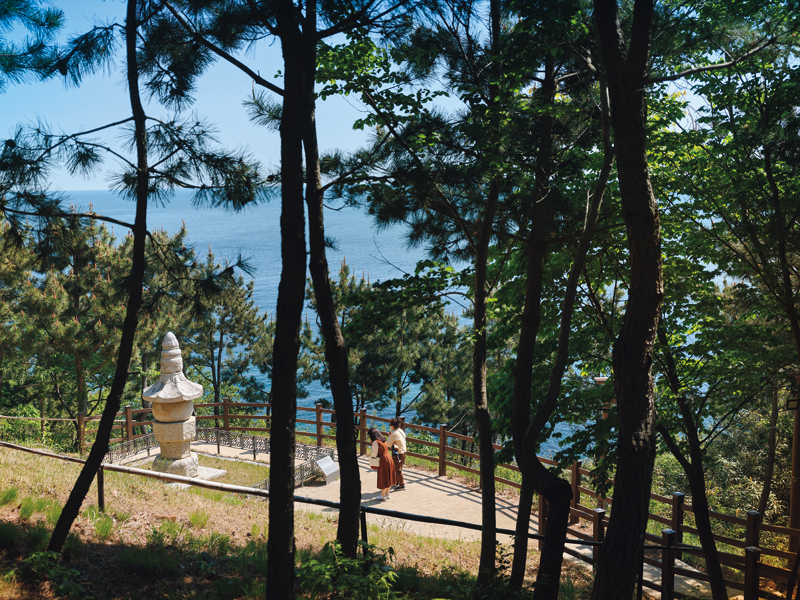
People pray in front of the Haesu Gwaneum (Avalokiteśvara Bodhisattva) Sarira Stupa at Naksan Temple. The temple is not only famous for its breathtaking scenery, but is also known as a “prayer sanctuary” or “gwaneum sanctuary” where many come to pray for their wishes.
SLEEPY YET VIBRANT
Naksan Temple has a history of more than 1,300 years. It is home to many cultural treasures, including a seven-story stone pagoda that had only three stories when it was initially built in 1467. Hongnyeon Hermitage exemplifies how nature and a culturally meaningful structure can form a beautiful ensemble. The building symbolizes the history of Naksan Temple, which was founded by the great monk Uisang after his legendary encounter with Avalokiteśvara Bodhisattva. It presents an exquisite sight, sitting precariously on a cliff facing the waters of the East Sea.
Tragically, more than 20 of Naksan Temple’s buildings were burned by fires that swept through the area in 2005. The melted bronze temple bell on display at the Uisang Memorial Hall is a lasting reminder of that painful time.
But the temple is indomitable. It has been destroyed and rebuilt many times since it was founded in 671. The losses of 2005 should not be thought of with sadness only. Opposite the melted bronze bell, a cello and violin are displayed, made from a building’s wooden beam that remained after the fire. The instruments seem to speak the locals’ desire to carry on their lives without buckling under adversity.
BEACHES AND PAVILION
If Naksan Temple is the height of static beauty, the bevy of surf shops around Jukdo Beach and Ingu Beach show the vitality of Yangyang. Around 70 percent of all surf shops in Korea are found in Yangyang, where the beaches have particularly clear water and waves of a decent size and frequency. In 2015, Hajodae Beach opened a one-kilometer stretch that became Korea’s first beach exclusively for surfing. Commonly known as “Surfyy Beach,” it is so crowded from late July to early August that people say it is filled “half with water and half with surfers.” Lessons are available even for complete beginners, and many travelers stay a few days to learn.
Between the beaches, in the Hajodae area, is Jukdo Pavilion. It sits on Mt. Jukdo, and the views from the forest trail and observatory are wonderful. Relaxing in the shade with a book, enjoying the sea breeze, one wonders if there could be a more perfect place to read.
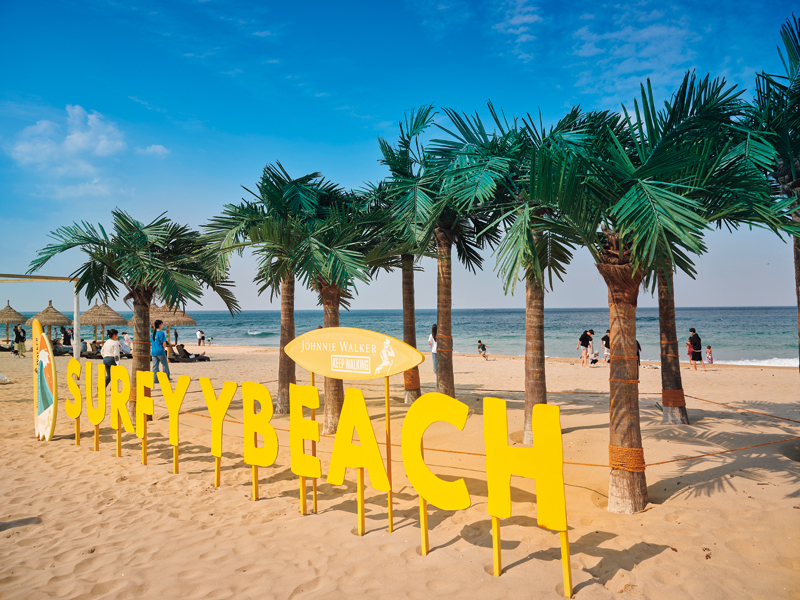
Surfyy Beach on the northern section of Hajodae is Korea’s first beach exclusively designated for surfing. Visitors can relax while taking in the exotic scenery, enjoying beach parties, or camping.
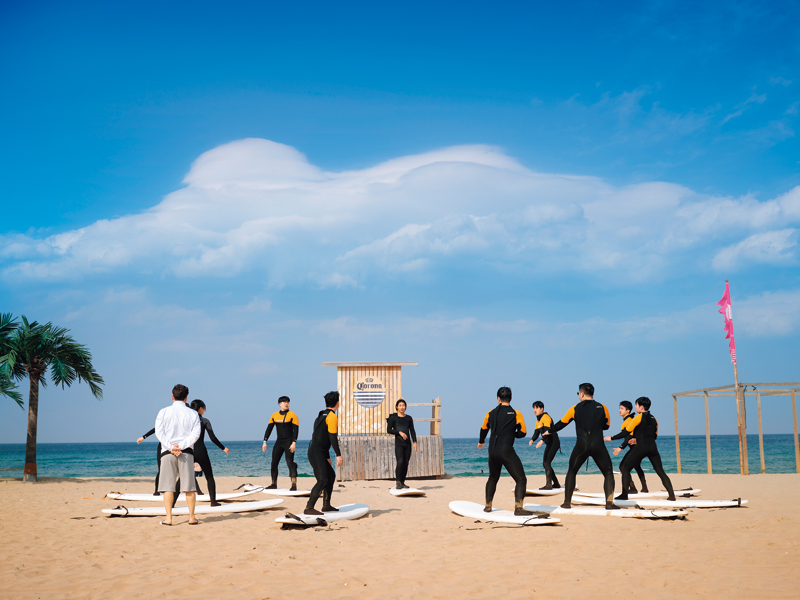
Surfyy Beach operates a surf school with classes for all levels, from beginner to upper intermediate. It also offers several other experience programs such as surf yoga, longboarding, and snorkeling
Hajodae is so beautiful that it has been designated as a scenic spot by the government. Looking out to sea from the pavilion, one can see a pine tree standing majestically on a huge rock. It is no ordinary pine tree, and most Koreans recognize it without ever having traveled here. When public television networks play the Korean anthem at the beginning and end of their daily broadcast, the tree appears in the accompanying video, just as the second verse begins.
In some ways, the tree seems to stand for Yangyang itself as a travel destination that has it all — mountains, valleys, the sea and beaches, and time-honored cultural heritage.
Kwon Ki-bong Writer
Lee Min-hee Photographer